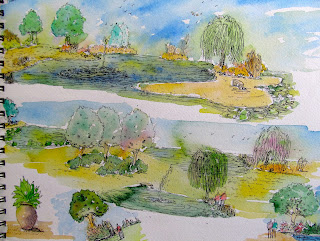 |
| (C) 2015 Dale DiMauro |
Earlier today, I came upon this little watercolor doodle on Arches 140 lb cold press paper, which was done a few months back. This close-up view reveals the texture of the watercolor paper, which was done on a scrap of paper the size of a large bookmark.
The abstract quality of this image is what caught my eye. The loosely painted sky with the simple tree-line and the reflections on the water remind me of some of Winslow Homer's Adirondack watercolors. The birds provide scale and movement to the scene.
I may be mistaken but am pretty sure I used just two pigments for this: Payne's gray and ultramarine blue. Sometimes with experimentation you can learn a lot through these little studies.







































